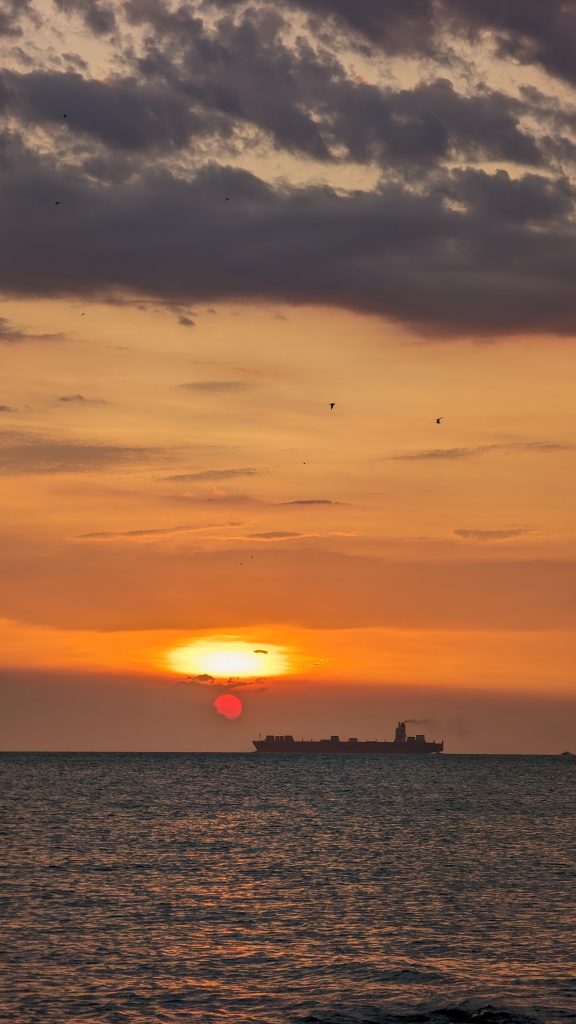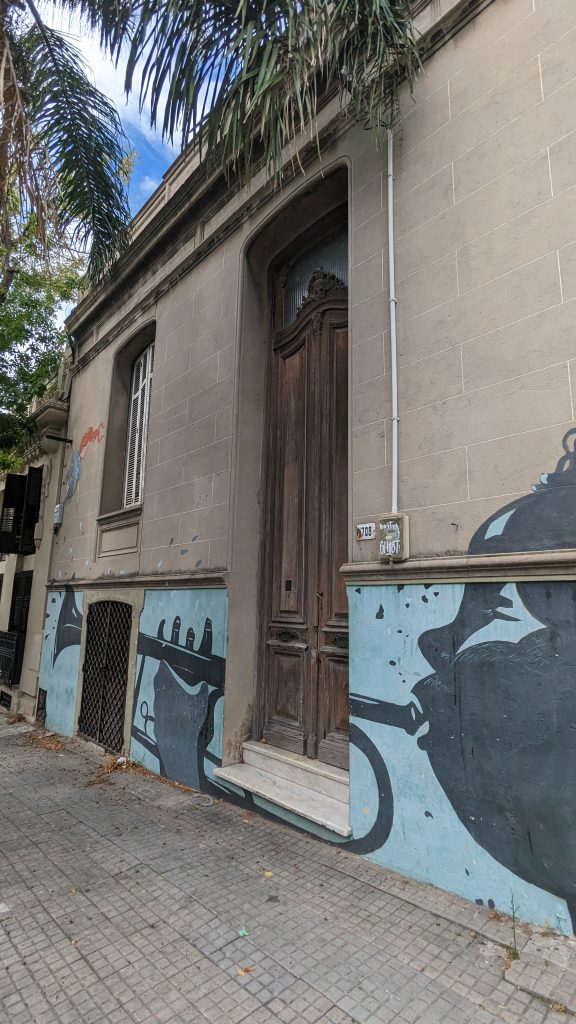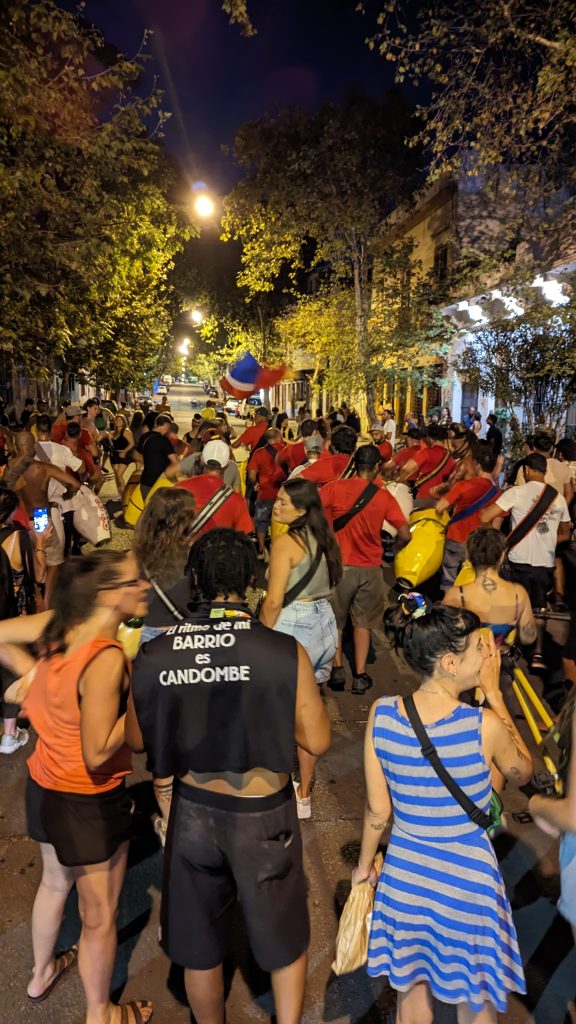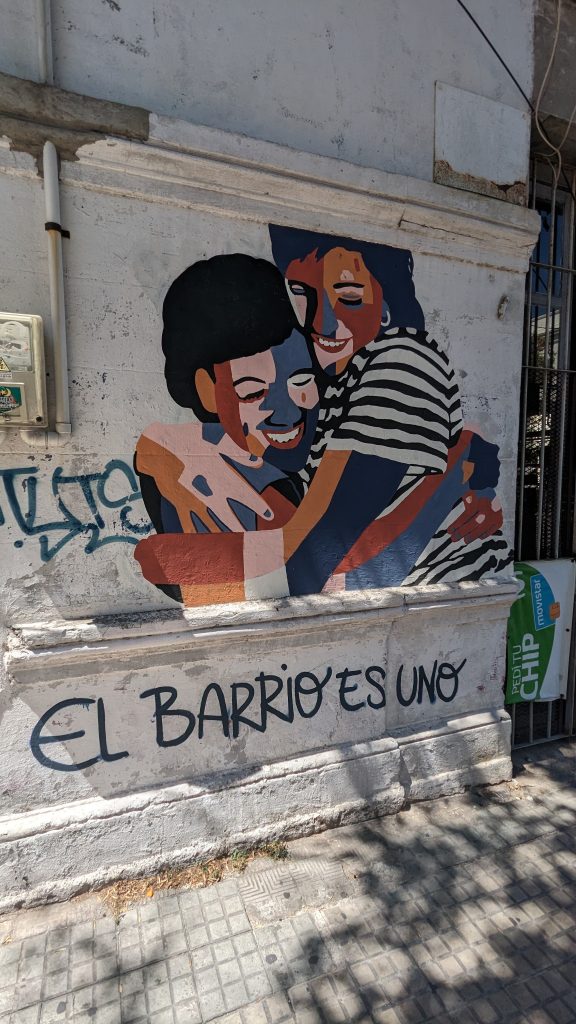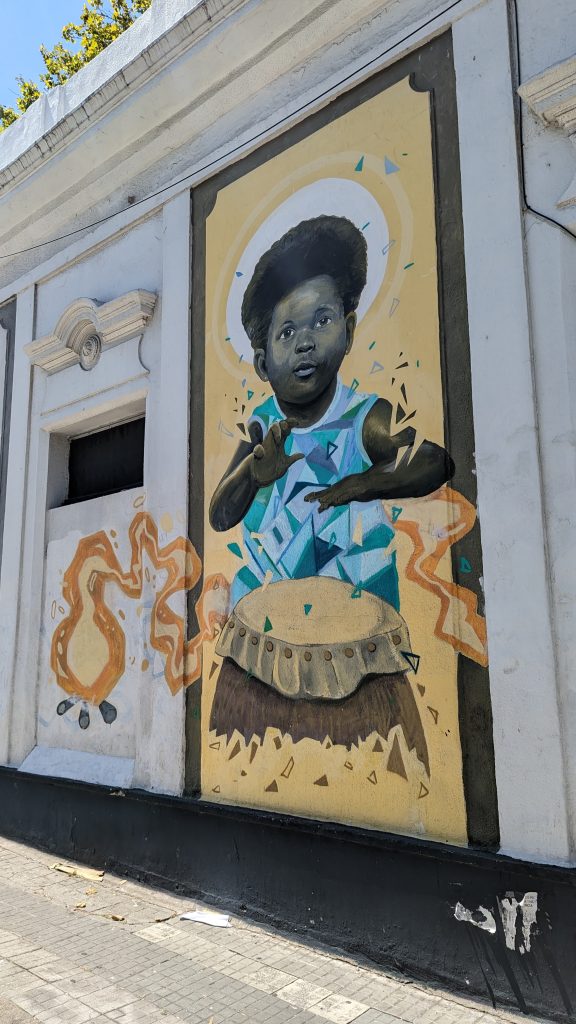We stayed in Barrio Sur, a very lively neighborhood known for Candombe, a Uruguayan form of drumming and dancing. Every Sunday evening until after 11:00PM, I heard the loud beating of the drums from our apartment. The performers dance and drum their way through the streets. Some of the people who live along the route step out of their house or watch from their windows or balconies; others join them and dance along. One of the locals who was walking along with them one night wore a shirt on which you could read: “El ritmo de mi barrio es Candombe”. You find murals throughout Barrio Sur and Palermo honoring this old tradition of Candombe.
Lots of our neighbors put their chairs out on the sidewalk on the weekend and chat with family and friends, while sometimes even having asado, placing a gigantic grill on the sidewalk or next to it. There and everywhere else in town, you can see Uruguayans on all days of the week and all times of the day with a flask of hot water and the traditional cup and straw drinking mate. It almost feels like it is more unlikely to see a Uruguayan without a mate cup in his or her hand than seeing a Uruguayan having a mate tea.
One of the lifelines of the town is the Rambla along the coast line, where apart from sitting and drinking mate, chatting or reading a book or fishing, lots of Montevideans like to go running, cycling, roller skating or for a walk. It can get pretty busy and I was surprised to see how active Montevideans seem to be. In some parts of Latin America, you won’t see local men in shorts, but only in long pants. Here everyone wears shorts and often men work out shirtless. Since I like to go running outdoors, it was nice not to be the only person in shorts and to be able to blend in. The vibe in Montevideo feels very European to me in some ways. You also find queserías in Montevideo, which sell a big variety of different cheeses, something I haven’t found in any other Latin American country so far. I’ve really missed a good selection of cheese in the last 6 months and was very happy about the choices here.
I love the fact that Uruguay is in many regards among the most secular countries in the world. While I do respect people’s beliefs, I strongly believe those beliefs should stay private and not be forced on others. (I don’t respect beliefs or parts of beliefs which go against human rights, abortion rights, gay marriage rights, women’s rights and so on.) In Uruguay, the Christian holidays don’t have Christian names, but are instead called family day (Christmas) or tourism week (Easter week) and there has been no religious education at school for the last 100 years. Uruguay managed to fully separate church and state a century ago.
Among my favorite things in Montevideo are the old small houses in Barrio Sur, Palermo and Cordón. You can also see a lot of beautiful street art in those neighborhoods. Pocitos has more modern high rises and seems to be generally cleaner but has less charm to me. Barrio Sur and Palermo have some grittines to it, which I don’t dislike. I get bored if everything is shiny and often you can find more street art and creative expression in the grittier parts of a town. Ciudad Vieja and the adjoining Plaza Independencia have a mix of old buildings–like the landmark Palacio Salvo, which, when construction finished in 1928, was the tallest building of Latin America–and buildings with an architectural style that is difficult to pin down. A funny thing you notice when walking on the sidewalks are dripping ACs. You find small puddles of water on the sidewalks here and there and sometimes notice something dripping on you. I think this also reflects the relaxedness of Montevideans, who seem to not really care about it. It got really hot in Montevideo, on occasion (up to 32° C / 90 F) and wouldn’t cool down at night, and therefore it was sometimes difficult for me to get a good night’s sleep since we lived in an old Art Deco building without an AC.
There are quite a few homeless people in Barrio Sur and Palermo sleeping on the sidewalks. Luckily there seemed to be several “ollas populares” – soup kitchens, where they were able to get a meal. The crime rate in Uruguay is among the lowest in Latin America, something I enjoyed a lot. It’s such a nice feeling to be able to sit on a beach in Montevideo after dark or walk through the streets without having to be scared. It adds so much to the quality of life.
I wasn’t able to find a yoga studio, where I could join ongoing classes but therefore I took up running again. After running just 4 times in Costa Rica, not running in Nicaragua at all and just once in Guatemala, I ran about 3 times a week here, which was about the same amount of times as in Panama City, where I also ran along the waterfront of the city. I love to practice running at a low altitude. I am capable of running at higher altitudes and once even ran a half marathon in Leh, Ladakh, at an altitude of 3500 meters / 11500 feet, but I prefer the ease of lower altitudes by 10 times.
Bee had a spring vacation and we took the opportunity to explore some towns along the coast. Uruguay unfortunately doesn’t have an active railway line operating in this region, so we rented a car. Our first stop was La Pedrera, which is supposed to be a party town during carnival, but was almost dead when we were there, with most restaurants being closed. We had the luck of the high season just being over and the beach was almost empty. I am not sure how busy it gets here during the high season, but I loved the empty beach in the low season. Driving further up the coast and in the neighboring La Paloma the experience was no different, with beautiful and almost-empty beaches in Punta del Diablo, Santa Teresa and Cabo Polonio. The coast of Rocha was a delight to visit and I would definitely come back for a longer beach vacation too, probably choosing Punta Diablo and Santa Teresa as the vacation spot.
Uruguay has the highest number of cows per capita in the world (more than three per person) and throughout our drive we could see what seemed like an endless amount of cattle grazing the pastures of Uruguay. Once we even saw cows in a field dotted with palm trees, which was a pretty picturesque sight.
On our way back to Montevideo we also spent a night in Punta del Este, the “Monte Carlo of the South,” where the rich Argentinians and Brazilians own apartments and like to vacation. Even Punta del Este’s endless beaches didn’t seem overcrowded. Kind of the theme here in Uruguay: Montevideo doesn’t get really crowded either.
To encourage tourism, the Uruguayan government doesn’t collect most or all of the VAT on some products when you pay with a foreign credit card. The rental car got significantly cheaper that way, along with eating in restaurants and drinking in bars. Groceries and hygiene articles are unfortunately extremely expensive and a major expense when living in Uruguay. Montevideo has a decent craft beer scene, comparable with Santiago de Chile, and foodies won’t fall short of options either.
Uruguay was an extremely positive experience. I loved the beaches and city life in Montevideo. I experienced a short nomad life burn out here too around the time when I wrote the blog post about the downsides of nomad life. I was craving more continuation of the same living conditions, probably propelled by the good conditions in Montevideo.
Now, I have already dived into the city life of Buenos Aires, a city which seems to be no less exciting and I am about to go on a 10-day Vipassana retreat, which is something I’ve wanted to do for a long time. I am equally excited and nervous about those 10 days. It will be 10 days of complete silence during which you are not allowed to talk (you can ask the meditation teacher questions, but should keep that too to a minimum.) There is no form of communication at all. You hand over your phone at the beginning of the retreat, no books, no journals to write in, just over 10 hours of meditation a day and short walks on the grounds of the center you can take alone. I am considered an “old student” since I have done this retreat once a long time ago in India, so I am not allowed to eat after noon. I am happy to get the opportunity to totally disconnect from the world for 10 days, something which is not easily achieved in our times, and I hope the meditation will be beneficial as well. I’ll keep you posted…!
